battery Acura TSX 2012 Owner's Guide
[x] Cancel search | Manufacturer: ACURA, Model Year: 2012, Model line: TSX, Model: Acura TSX 2012Pages: 324, PDF Size: 9.45 MB
Page 270 of 324

269
Maintenance
Remote Transmitter CareReplacing the BatteryIf the indicator does not come on when the button is pushed, replace the battery.
1.Unscrew the cover with a small Phillips-
head screwdriver. Push a button to pry
open the transmitter.
2.Open the keypad.
uWrap the small flat-tip screwdriver with a
cloth to prevent scratching the
transmitter.
3.Make sure to replace the battery with the
correct polarity.
1Replacing the Battery
NOTICEAn improperly disposed of battery can damage the
environment. Always confirm local regulations for
battery disposal.
Replacement batteries are commercially available or
at a dealer.
Keypad
Screw
Battery type: CR1616
Battery
Page 275 of 324

uuCleaninguExterior Care
274Maintenance
A good coat of automotive body wax helps protect your vehicle’s paint from the
elements. Wax will wear off over time and expose your vehicle’s paint to the
elements, so reapply as necessary.
If you get gasoline, oil, engine coolant, or battery fluid on resin coated parts, they
may be stained or the coating may peel. Promptly wipe it away using a soft cloth and
clean water.
Wipe using a glass cleaner.
Aluminum is susceptible to deterioration caused by salt and other road
contaminants. Use a sponge and mild detergent to wipe away promptly.
Be careful not to use harsh chemicals (including some commercial wheel cleaners) or
a stiff brush. They can damage the clear coat of the aluminum alloy wheels that
helps keep the aluminum from corroding and tarnishing.■
Applying Wax
■
Maintaining the Bumpers and Other Resin Coated Parts
■
Cleaning the Window
■
Maintaining Aluminum Wheels
1Applying Wax
NOTICEChemical solvents and strong cleaners can damage
the paint, metal, and plastic on your vehicle. Wipe up
spills immediately.1Maintaining the Bumpers and Other Resin Coated Parts
Ask a dealer about the correct coating material when
you want to repair the painted surface of the parts
made of resin.1Cleaning the Window
Wires are mounted to the inside of the rear window.
Wipe along the same direction as the wires with a
soft cloth so as not to damage them.
Page 284 of 324
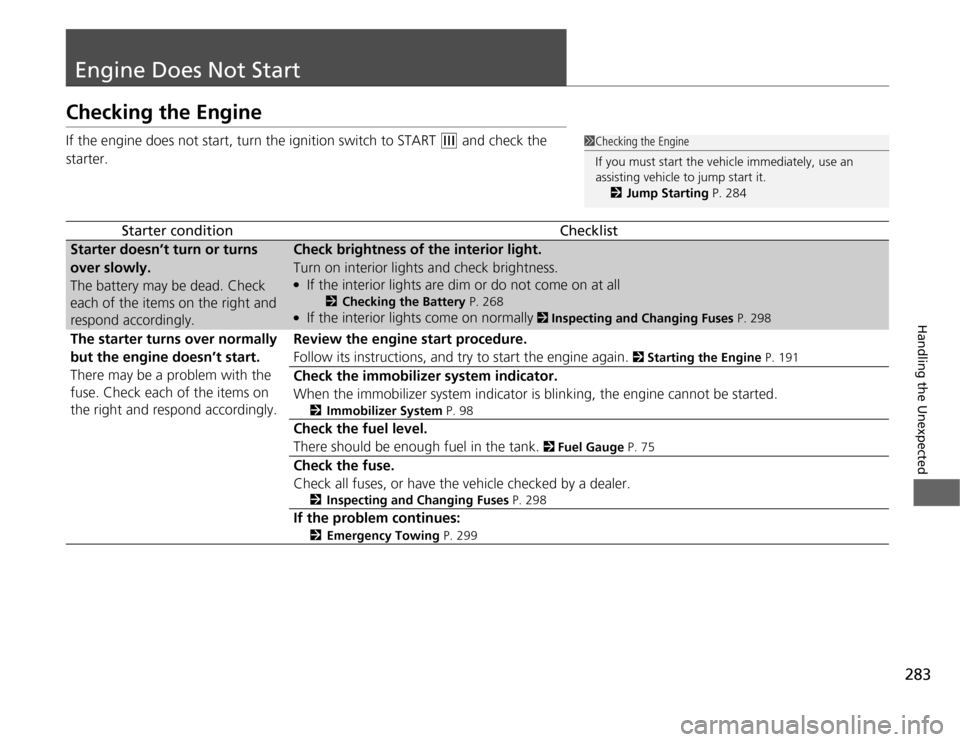
283
Handling the Unexpected
Engine Does Not StartChecking the EngineIf the engine does not start, turn the ignition switch to START
(e
and check the
starter.
Starter condition
Checklist
Starter doesn’t turn or turns
over slowly.
The battery may be dead. Check
each of the items on the right and
respond accordingly.
Check brightness of the interior light.
Turn on interior lights and check brightness.●
If the interior lights are dim or do not come on at all
2Checking the Battery P. 268
●
If the interior lights come on normally
2 Inspecting and Changing Fuses P. 298
The starter turns over normally
but the engine doesn’t start.
There may be a problem with the
fuse. Check each of the items on
the right and respond accordingly.
Review the engine start procedure.
Follow its instructions, and try to start the engine again.
2 Starting the Engine P. 191
Check the immobilizer system indicator.
When the immobilizer system indicator is blinking, the engine cannot be started.
2Immobilizer System P. 98
Check the fuel level.
There should be enough fuel in the tank.
2 Fuel Gauge P. 75
Check the fuse.
Check all fuses, or have the vehicle checked by a dealer.
2Inspecting and Changing Fuses P. 298
If the problem continues:
2Emergency Towing P. 299
1Checking the Engine
If you must start the vehicle immediately, use an
assisting vehicle to jump start it.
2Jump Starting P. 284
Page 285 of 324
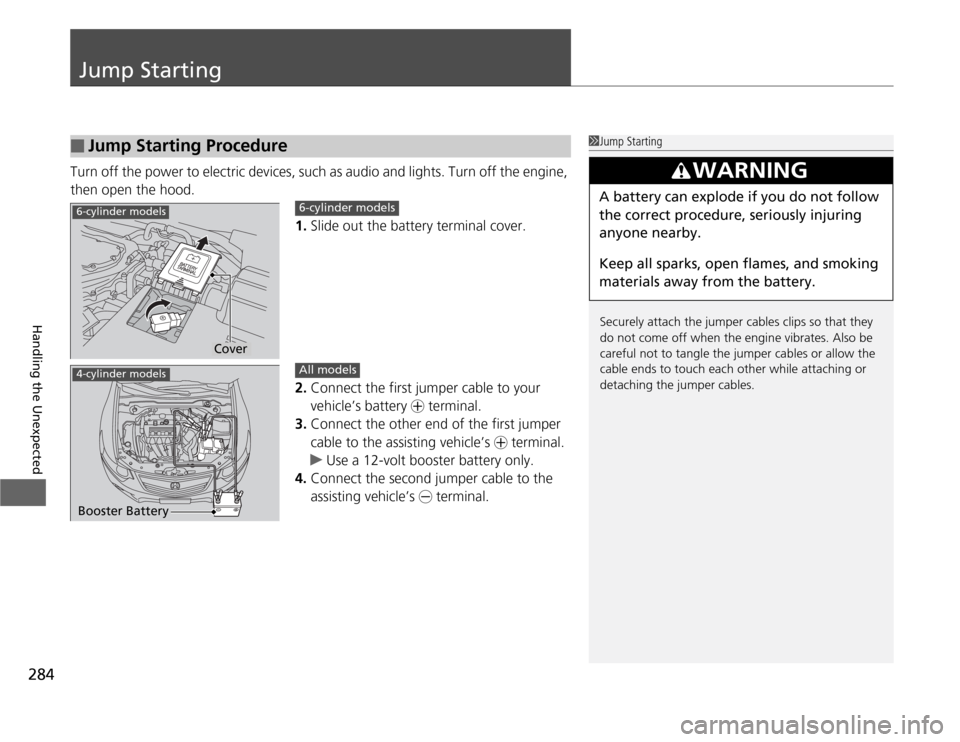
284Handling the Unexpected
Jump StartingTurn off the power to electric devices, such as audio and lights. Turn off the engine,
then open the hood.
1.Slide out the battery terminal cover.
2.Connect the first jumper cable to your
vehicle’s battery + terminal.
3.Connect the other end of the first jumper
cable to the assisting vehicle’s + terminal.
uUse a 12-volt booster battery only.
4.Connect the second jumper cable to the
assisting vehicle’s - terminal.■
Jump Starting Procedure
1Jump Starting
Securely attach the jumper cables clips so that they
do not come off when the engine vibrates. Also be
careful not to tangle the jumper cables or allow the
cable ends to touch each other while attaching or
detaching the jumper cables.
3
WARNING
A battery can explode if you do not follow
the correct procedure, seriously injuring
anyone nearby.
Keep all sparks, open flames, and smoking
materials away from the battery.
Cover
6-cylinder models
6-cylinder models
4-cylinder modelsBooster Battery
All models
Page 286 of 324
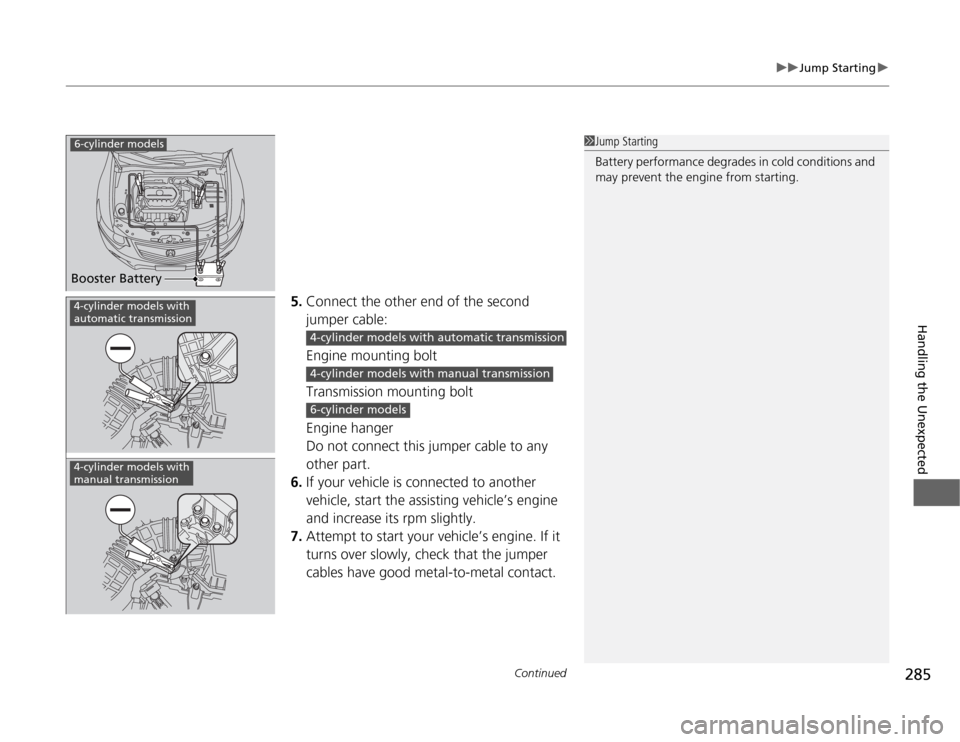
Continued
285
uuJump Startingu
Handling the Unexpected
5.Connect the other end of the second
jumper cable:
Engine mounting bolt
Transmission mounting bolt
Engine hanger
Do not connect this jumper cable to any
other part.
6.If your vehicle is connected to another
vehicle, start the assisting vehicle’s engine
and increase its rpm slightly.
7.Attempt to start your vehicle’s engine. If it
turns over slowly, check that the jumper
cables have good metal-to-metal contact.
1Jump Starting
Battery performance degrades in cold conditions and
may prevent the engine from starting.
6-cylinder modelsBooster Battery4-cylinder models with
automatic transmission4-cylinder models with
manual transmission
4-cylinder models with automatic transmission4-cylinder models with manual transmission6-cylinder models
Page 287 of 324
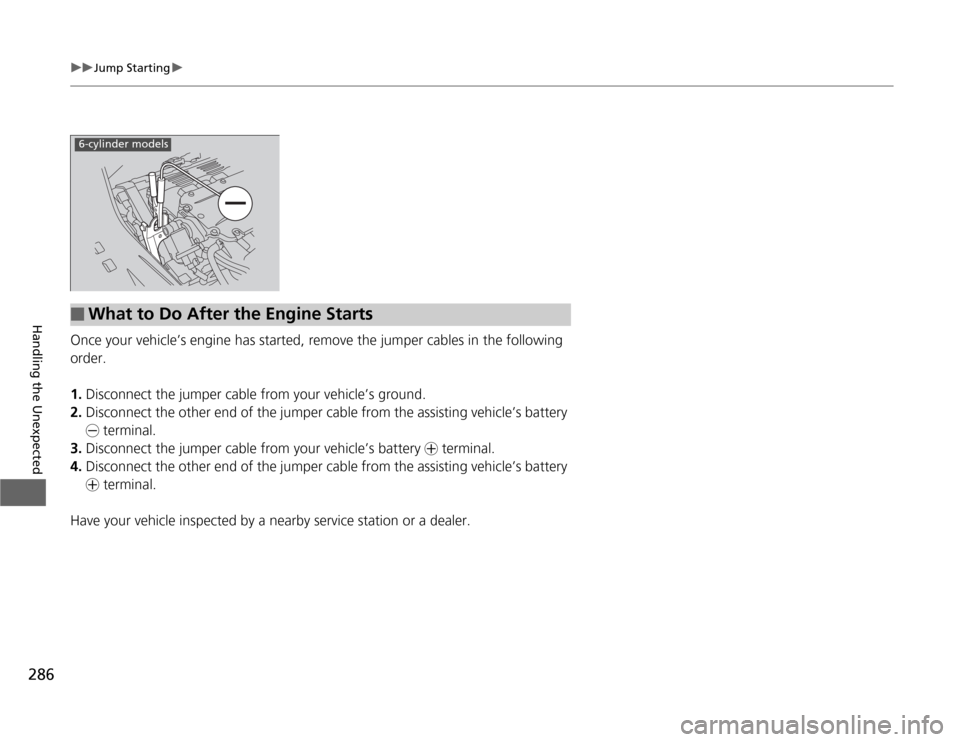
286
uuJump Startingu
Handling the Unexpected
Once your vehicle’s engine has started, remove the jumper cables in the following
order.
1.Disconnect the jumper cable from your vehicle’s ground.
2.Disconnect the other end of the jumper cable from the assisting vehicle’s battery
- terminal.
3.Disconnect the jumper cable from your vehicle’s battery + terminal.
4.Disconnect the other end of the jumper cable from the assisting vehicle’s battery
+ terminal.
Have your vehicle inspected by a nearby service station or a dealer.6-cylinder models■
What to Do After the Engine Starts
Page 291 of 324

290Handling the Unexpected
Indicator, Coming On/BlinkingIf the Low Oil Pressure Indicator Comes On
■
Reasons for the indicator to come on
Comes on when the engine oil pressure is low.
■
What to do as soon as the indicator comes on
1.Immediately park the vehicle in a safe place.
2.If necessary, turn the hazard warning lights on.
■
What to do after parking the vehicle
1.Stop the engine and let it sit for about one minute.
2.Open the hood and check the oil level.
uAdd oil as necessary.
3.Start the engine and check the low oil pressure indicator.
uThe light goes out: Start driving again.
uThe light does not go out within 10 seconds: Stop the engine and
contact a dealer for repairs immediately.
If the Charging System Indicator Comes On
■
Reasons for the indicator to come on
Comes on when the battery is not being charged.
■
What to do when the indicator comes on
Turn off the climate control system, rear defogger, and other electrical
systems, and immediately contact a dealer for repairs.
1If the Low Oil Pressure Indicator Comes On
NOTICERunning the engine with low oil pressure can cause
serious mechanical damage almost immediately.1If the Charging System Indicator Comes On
If you need to stop temporarily, do not turn off the
engine. Restarting the engine may rapidly discharge
the battery.
Page 297 of 324
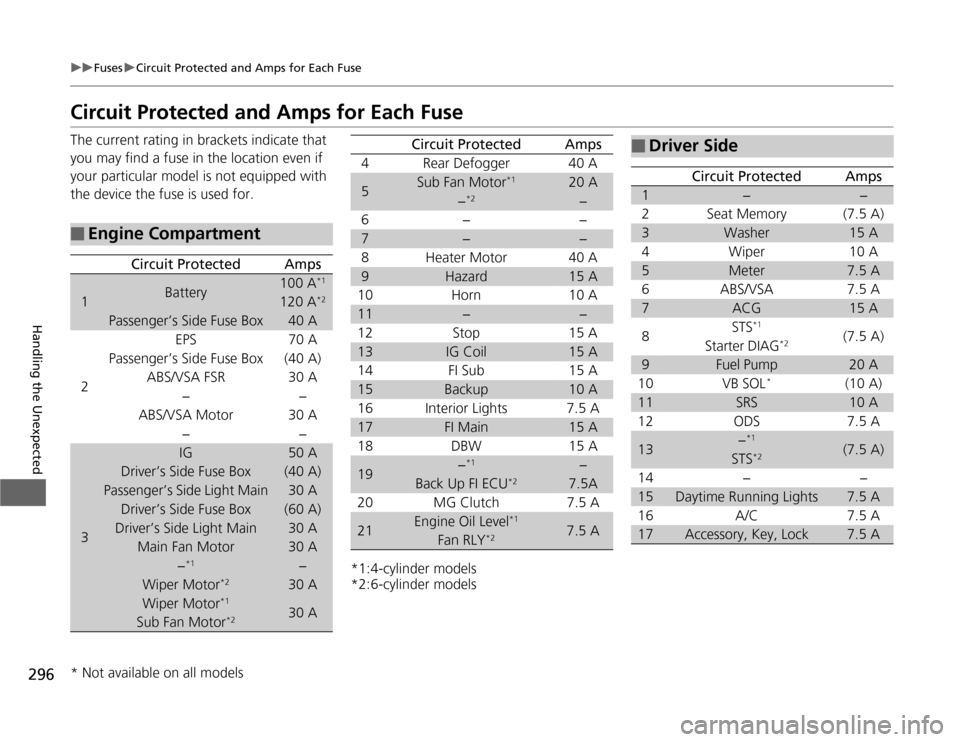
296
uuFusesuCircuit Protected and Amps for Each Fuse
Handling the Unexpected
Circuit Protected and Amps for Each FuseThe current rating in brackets indicate that
you may find a fuse in the location even if
your particular model is not equipped with
the device the fuse is used for.■
Engine Compartment
Circuit Protected
Amps
1
Battery
100 A
*1
120 A
*2
Passenger’s Side Fuse Box
40 A
2
EPS
70 A
Passenger’s Side Fuse Box (40 A)
ABS/VSA FSR
30 A
−−
ABS/VSA Motor
30 A
−−
3
IG
50 A
Driver’s Side Fuse Box
(40 A)
Passenger’s Side Light Main
30 A
Driver’s Side Fuse Box
(60 A)
Driver’s Side Light Main
30 A
Main Fan Motor
30 A
−*1
−
Wiper Motor
*2
30 A
Wiper Motor
*1
30 A
Sub Fan Motor
*2
*1:4-cylinder models
*2:6-cylinder models4 Rear Defogger 40 A5
Sub Fan Motor
*1
20 A
−*2
−
6− −
7
−
−
8 Heater Motor 40 A
9
Hazard
15 A
10 Horn 10 A
11
−
−
12 Stop 15 A
13
IG Coil
15 A
14 FI Sub 15 A
15
Backup
10 A
16 Interior Lights 7.5 A
17
FI Main
15 A
18 DBW 15 A
19
−*1
−
Back Up FI ECU
*2
7.5A
20 MG Clutch 7.5 A
21
Engine Oil Level
*1
7.5 A
Fan RLY
*2
Circuit Protected
Amps
■
Driver Side
Circuit Protected
Amps
1
−
−
2
Seat Memory
(7.5 A)
3
Washer
15 A
4
Wiper
10 A
5
Meter
7.5 A
6
ABS/VSA
7.5 A
7
ACG
15 A
8
STS
*1
(7.5 A)
Starter DIAG
*2
9
Fuel Pump
20 A
10
VB SOL
*
(10 A)
11
SRS
10 A
12
ODS
7.5 A
13
−*1
(7.5 A)
STS
*2
14
−
−
15
Daytime Running Lights
7.5 A
16
A/C
7.5 A
17
Accessory, Key, Lock
7.5 A
* Not available on all models
Page 305 of 324
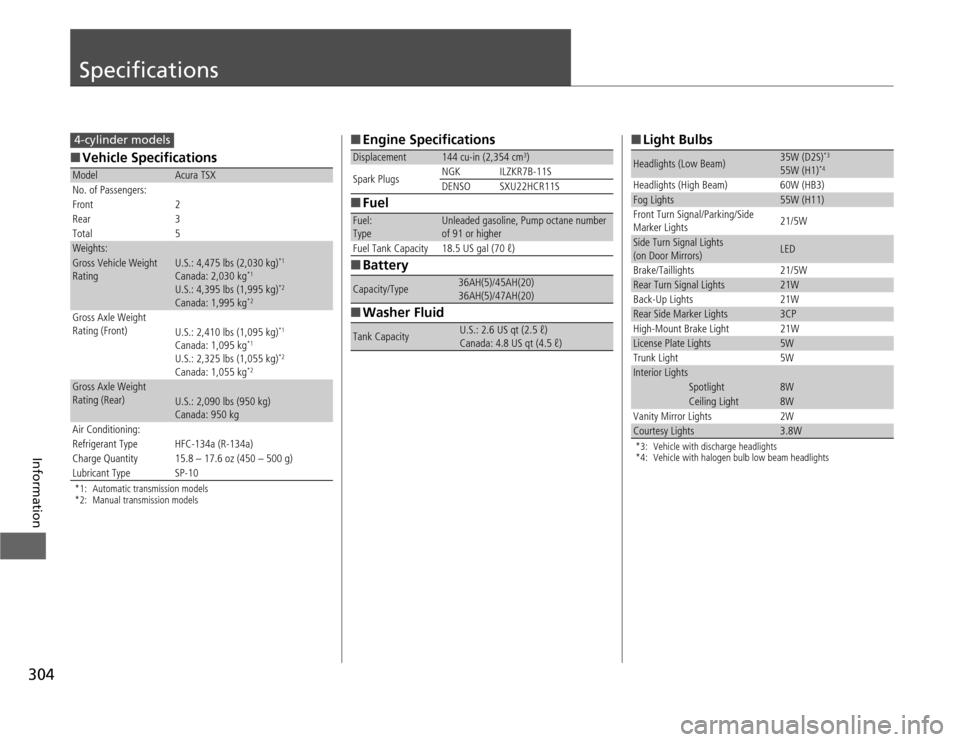
304Information
Specifications■Vehicle Specifications*1: Automatic transmission models
*2: Manual transmission modelsModel
Acura TSX
No. of Passengers:
Front 2
Rear 3
Total 5
Weights:Gross Vehicle Weight
Rating
U.S.: 4,475 lbs (2,030 kg)
*1
Canada: 2,030 kg
*1
U.S.: 4,395 lbs (1,995 kg)
*2
Canada: 1,995 kg
*2
Gross Axle Weight
Rating (Front)
U.S.: 2,410 lbs (1,095 kg)
*1
Canada: 1,095 kg
*1
U.S.: 2,325 lbs (1,055 kg)
*2
Canada: 1,055 kg
*2
Gross Axle Weight
Rating (Rear)
U.S.: 2,090 lbs (950 kg)
Canada: 950 kg
Air Conditioning:
Refrigerant Type HFC-134a (R-134a)
Charge Quantity 15.8 – 17.6 oz (450 – 500 g)
Lubricant Type SP-10
4-cylinder models
■Engine Specifications
■Fuel
■Battery
■Washer FluidDisplacement
144 cu-in (2,354 cm
3)
Spark PlugsNGK ILZKR7B-11S
DENSO SXU22HCR11S
Fuel:
Type
Unleaded gasoline, Pump octane number
of 91 or higher
Fuel Tank Capacity 18.5 US gal (70 ℓ)
Capacity/Type
36AH(5)/45AH(20)
36AH(5)/47AH(20)
Tank Capacity
U.S.: 2.6 US qt (2.5 ℓ)
Canada: 4.8 US qt (4.5 ℓ)
■Light Bulbs*3: Vehicle with discharge headlights
*4: Vehicle with halogen bulb low beam headlightsHeadlights (Low Beam)
35W (D2S)
*3
55W (H1)
*4
Headlights (High Beam) 60W (HB3)Fog Lights
55W (H11)
Front Turn Signal/Parking/Side
Marker Lights21/5W
Side Turn Signal Lights
(on Door Mirrors)
LED
Brake/Taillights 21/5W
Rear Turn Signal Lights
21W
Back-Up Lights 21W
Rear Side Marker Lights
3CP
High-Mount Brake Light 21W
License Plate Lights
5W
Trunk Light 5W
Interior Lights
Spotlight
8W
Ceiling Light
8W
Vanity Mirror Lights 2W
Courtesy Lights
3.8W
Page 307 of 324
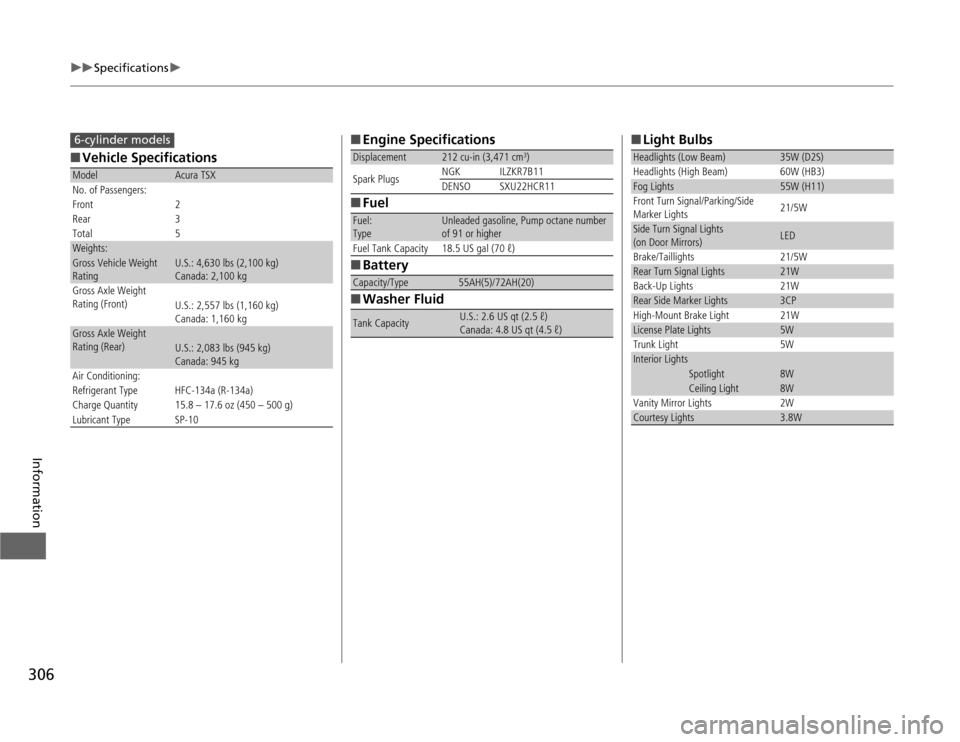
306
uuSpecificationsu
Information
■Vehicle SpecificationsModel
Acura TSX
No. of Passengers:
Front 2
Rear 3
Total 5
Weights:Gross Vehicle Weight
Rating
U.S.: 4,630 lbs (2,100 kg)
Canada: 2,100 kg
Gross Axle Weight
Rating (Front)
U.S.: 2,557 lbs (1,160 kg)
Canada: 1,160 kg
Gross Axle Weight
Rating (Rear)
U.S.: 2,083 lbs (945 kg)
Canada: 945 kg
Air Conditioning:
Refrigerant Type HFC-134a (R-134a)
Charge Quantity 15.8 – 17.6 oz (450 – 500 g)
Lubricant Type SP-10
6-cylinder models
■Engine Specifications
■Fuel
■Battery
■Washer FluidDisplacement
212 cu-in (3,471 cm
3)
Spark PlugsNGK ILZKR7B11
DENSO SXU22HCR11
Fuel:
Type
Unleaded gasoline, Pump octane number
of 91 or higher
Fuel Tank Capacity 18.5 US gal (70 ℓ)
Capacity/Type
55AH(5)/72AH(20)
Tank Capacity
U.S.: 2.6 US qt (2.5 ℓ)
Canada: 4.8 US qt (4.5 ℓ)
■Light BulbsHeadlights (Low Beam)
35W (D2S)
Headlights (High Beam) 60W (HB3)
Fog Lights
55W (H11)
Front Turn Signal/Parking/Side
Marker Lights21/5W
Side Turn Signal Lights
(on Door Mirrors)
LED
Brake/Taillights 21/5W
Rear Turn Signal Lights
21W
Back-Up Lights 21W
Rear Side Marker Lights
3CP
High-Mount Brake Light 21W
License Plate Lights
5W
Trunk Light 5W
Interior Lights
Spotlight
8W
Ceiling Light
8W
Vanity Mirror Lights 2W
Courtesy Lights
3.8W